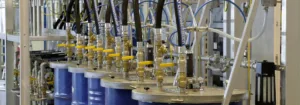Air motors, also known as pneumatic motors, offer unique advantages in various industrial applications. Their design, performance, and safety features make them a compelling choice for specific scenarios. In this article, we delve into the technical aspects of air motors, highlighting their key characteristics and benefits.
1. Compact and Lightweight
Air motors exhibit an impressive power-to-weight ratio. Compared to electric motors with similar output, air motors weigh only a fraction and occupy minimal space. This compactness allows for efficient integration into tight spaces or portable equipment.
2. Torque Increases with Load
Unlike some other motor types, air motors maintain relatively constant output within a wide speed range. Interestingly, when the load increases and speed decreases, the torque actually rises. This inherent characteristic ensures consistent performance across varying conditions.
3. Steplessly Adjustable Power Output
Air motors provide precise control over torque and speed. By adjusting the working pressure, operators can smoothly modulate the motor’s output. This flexibility is advantageous for applications requiring fine-tuning or varying power levels.
4. Overload Resilience
Air motors are remarkably resilient to overloads. They can be stalled indefinitely without overheating or sustaining damage. This robustness allows for continuous operation even under challenging conditions.
5. Reversible Operation
Air motor operate efficiently in both directions. Reversing the motor’s rotation is straightforward using a directional valve. This versatility is valuable for applications where bidirectional movement is necessary.
6. Safety in Hazardous Environments
One of the standout features of air motor is their safety profile. They do not generate sparks during operation, making them suitable for environments with explosion or fire hazards. Additionally, their rugged design withstands corrosive atmospheres and salt-laden conditions.
7. Simple Installation and Positioning
Installing air motor is straightforward. They can work in any position—horizontal, vertical, or even upside-down. Connecting the necessary air lines is uncomplicated, simplifying integration into existing systems.
8. Rugged Durability
Air motor excel in harsh environments. Their resistance to heat, vibration, and impacts surpasses that of electric motors. Whether in manufacturing, mining, or marine applications, air motors prove their reliability.
To summarize, Air motor offer a compelling blend of compactness, safety, and adaptability. Understanding their technical characteristics empowers engineers and operators to make informed choices for specific tasks. As you explore motor options, consider the unique benefits that air motor bring to the table.
Remember, each type of air motor (vane, piston, or turbine) has its own design and operational principles. Choose wisely based on your application requirements and enjoy the advantages of this remarkable technology.
If you need further information, please feel free to contact our expert. For further insights and detailed technical information, consult the Pocket Guide to Air Motors by Atlas Copco or Contact us directly.


